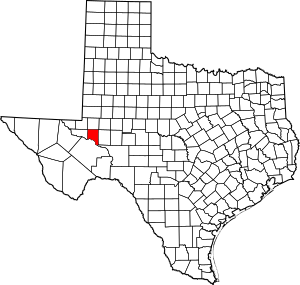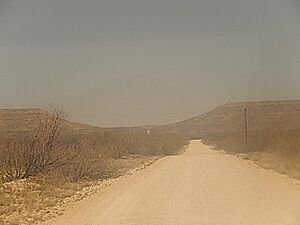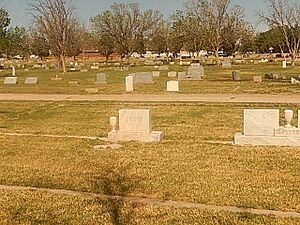Crane County, Texas facts for kids
Quick facts for kids
Crane County
|
|
|---|---|

Crane County Courthouse in Crane
|
|

Location within the U.S. state of Texas
|
|
 Texas's location within the U.S. |
|
| Country | |
| State | |
| Founded | 1927 |
| Named for | William Carey Crane |
| Seat | Crane |
| Largest city | Crane |
| Area | |
| • Total | 786 sq mi (2,040 km2) |
| • Land | 785 sq mi (2,030 km2) |
| • Water | 0.7 sq mi (2 km2) 0.08% |
| Population
(2020)
|
|
| • Total | 4,675 |
| • Density | 5.948/sq mi (2.2965/km2) |
| Time zone | UTC−6 (Central) |
| • Summer (DST) | UTC−5 (CDT) |
| Congressional district | 23rd |
Crane County is a county in the state of Texas. In 2020, about 4,675 people lived there. The main town, called the county seat, is Crane. The county was started in 1887 and officially set up in 1927. It was named after William Carey Crane, who was a president of Baylor University.
Contents
History of Crane County
Early Inhabitants: Native Americans
Long ago, Native American tribes lived in the Crane County area. Tribes like the Comanches, Lipan Apache, and Kiowa called this land home.
How Crane County Started
Crane County was created in 1887 from Tom Green County. It was named after William Carey Crane. Not many people lived here at first. In 1900, only 51 people and 12 ranches were counted. The county didn't even have roads until 1918.
Oil Discovery and Growth
Things changed in 1925 when a company started looking for oil. The first oil well began producing in March 1926. This discovery brought many people to the area. By 1927, about 6,000 people lived in the county. Most of them, about 4,500, lived in the town of Crane. Water was expensive and had to be brought in by trucks.
Since 1926, a lot of oil has been produced in Crane County. The county's history is kept safe at the Museum of the Desert Southwest. This museum opened in Crane in 1980.
Geography and Nature
Crane County covers about 786 square miles. Most of this area, 785 square miles, is land. Only a small part, about 0.7 square miles, is water.
Between Crane and McCamey is a special place called Castle Gap. This is a break in a high, flat landform called a mesa. It's about 12 miles east of the Pecos River. Long ago, Comanches, people traveling to the California Gold Rush, and cowboys moving cattle used this gap. It was an important path on the Goodnight-Loving Trail.
Main Roads in Crane County
Neighboring Counties
Crane County shares borders with these other counties:
- Ector County (north)
- Upton County (east)
- Crockett County (southeast)
- Pecos County (south)
- Ward County (west)
Population of Crane County
| Historical population | |||
|---|---|---|---|
| Census | Pop. | %± | |
| 1890 | 15 | — | |
| 1900 | 51 | 240.0% | |
| 1910 | 331 | 549.0% | |
| 1920 | 37 | −88.8% | |
| 1930 | 2,221 | 5,902.7% | |
| 1940 | 2,841 | 27.9% | |
| 1950 | 3,965 | 39.6% | |
| 1960 | 4,699 | 18.5% | |
| 1970 | 4,172 | −11.2% | |
| 1980 | 4,600 | 10.3% | |
| 1990 | 4,652 | 1.1% | |
| 2000 | 3,996 | −14.1% | |
| 2010 | 4,375 | 9.5% | |
| 2020 | 4,675 | 6.9% | |
| U.S. Decennial Census 1850–2010 2010 2020 |
|||
In 2000, there were 3,996 people living in Crane County. There were 1,360 households, which are groups of people living together. About 43.4% of these households had children under 18. The average household had about 2.91 people.
The median age in the county was 34 years old. This means half the people were younger than 34 and half were older. For every 100 females, there were about 94.8 males.
The median income for a household was $32,194 per year. This is the middle income for all households. About 13.4% of the population lived below the poverty line. This included 15.3% of children under 18.
Economy of Crane County
The biggest part of Crane County's economy is producing oil and gas. The Waddell Ranch in the county has many oil wells. Crane County is one of the largest oil-producing counties in Texas. A huge amount of oil has been pumped from the ground here since 1926.
Other important jobs in the county include cattle ranching and working for the local government. Over 503,000 acres of land are used for raising livestock.
Communities in Crane County
City
- Crane (This is the county seat, the main town)
Unincorporated Community
Education in Crane County
All students in Crane County attend schools in the Crane Independent School District. After high school, students can go to Odessa College. The entire county is part of Odessa College's service area.
See also
- Crane County from the Handbook of Texas Online
 |
Ector County |  |
||
| Ward County | Upton County | |||
| Pecos County | Crockett County |
 In Spanish: Condado de Crane para niños
In Spanish: Condado de Crane para niños



